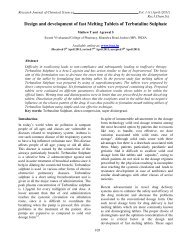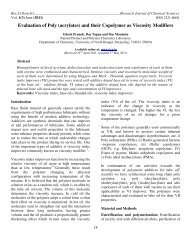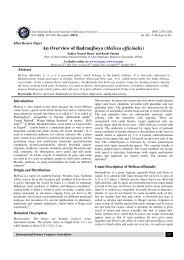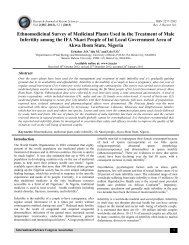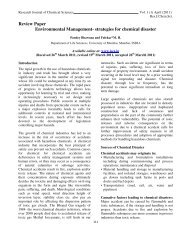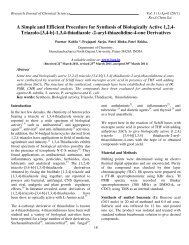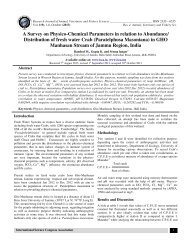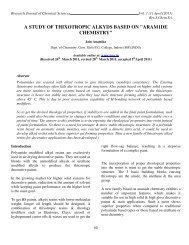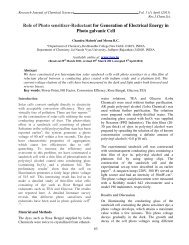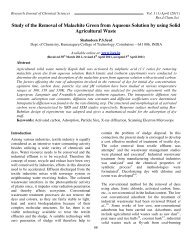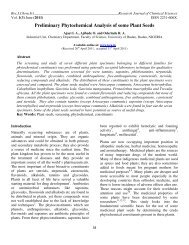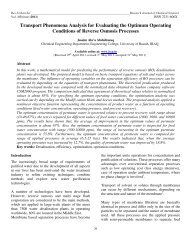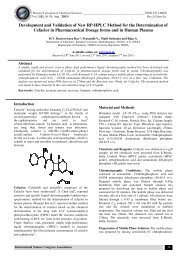Effect of Micro Silica on The Strength of Concrete with ... - ISCA
Effect of Micro Silica on The Strength of Concrete with ... - ISCA
Effect of Micro Silica on The Strength of Concrete with ... - ISCA
Create successful ePaper yourself
Turn your PDF publications into a flip-book with our unique Google optimized e-Paper software.
Abstract<br />
Research Journal <str<strong>on</strong>g>of</str<strong>on</strong>g> Engineering Sciences ___________________________________________ ISSN 2278 – 9472<br />
Vol. 1(3), 1-4, Sept. (2012)<br />
Res. J. Engineering Sci.<br />
<str<strong>on</strong>g>Effect</str<strong>on</strong>g> <str<strong>on</strong>g>of</str<strong>on</strong>g> <str<strong>on</strong>g>Micro</str<strong>on</strong>g> <str<strong>on</strong>g>Silica</str<strong>on</strong>g> <strong>on</strong> <strong>The</strong> <strong>Strength</strong> <str<strong>on</strong>g>of</str<strong>on</strong>g> C<strong>on</strong>crete <strong>with</strong> Ordinary<br />
Portland Cement<br />
Verma Ajay 1 , Chandak Rajeev 2 and Yadav R.K. 2<br />
1 Structural Engineering Department, Jabalpur Engineering College, Jabalpur, MP, INDIA<br />
2 Civil Engineering Department, Jabalpur Engineering College, Jabalpur, MP, INDIA<br />
Available <strong>on</strong>line at: www.isca.in<br />
Received 2 nd June 2012, revised 10 th June 2012, accepted 15 th June 2012<br />
C<strong>on</strong>crete is the most important engineering material and the additi<strong>on</strong> <str<strong>on</strong>g>of</str<strong>on</strong>g> some other materials may change the properties <str<strong>on</strong>g>of</str<strong>on</strong>g><br />
c<strong>on</strong>crete. With increase in trend towards the wider use <str<strong>on</strong>g>of</str<strong>on</strong>g> c<strong>on</strong>crete for prestressed c<strong>on</strong>crete and high rise buildings there is a<br />
growing demand <str<strong>on</strong>g>of</str<strong>on</strong>g> c<strong>on</strong>crete <strong>with</strong> higher compressive strength. Mineral additi<strong>on</strong>s which are also known as mineral<br />
admixtures have been used <strong>with</strong> cements for many years. <strong>The</strong>re are two tpes <str<strong>on</strong>g>of</str<strong>on</strong>g> materials crystalline and n<strong>on</strong> crystalline.<br />
<str<strong>on</strong>g>Micro</str<strong>on</strong>g> silica or silica fume is very fine n<strong>on</strong> crystalline material. <str<strong>on</strong>g>Silica</str<strong>on</strong>g> fume is produced in electric arc furnace as a by<br />
product <str<strong>on</strong>g>of</str<strong>on</strong>g> the producti<strong>on</strong> <str<strong>on</strong>g>of</str<strong>on</strong>g> elemental silic<strong>on</strong>s or alloys c<strong>on</strong>taining silic<strong>on</strong>. IT is usually a gray coloured powder somewhat<br />
similar to portland or some fly ashes silica fume is generally categorized as a supplymentry cementitious material. <str<strong>on</strong>g>Silica</str<strong>on</strong>g><br />
fume or micro silica was initially vied as cement rplacement material and in some area it is usually used as replaced by<br />
much smaller quantity <str<strong>on</strong>g>of</str<strong>on</strong>g> silica fume micro silica may be used as pozzolanic admixtures. Admixture is defined as a material<br />
other than cement water and aggregate that is used as ingredient <str<strong>on</strong>g>of</str<strong>on</strong>g> c<strong>on</strong>crete and is added to the batch immediately before or<br />
during mixing. Pozzolanic admixtures are siliceous or aluminous material which is themselves posses little or no<br />
cementitious value but will in finely divided form and in the presence <str<strong>on</strong>g>of</str<strong>on</strong>g> water chemically react <strong>with</strong> calcium hydroxide<br />
liberated <strong>on</strong> hydrati<strong>on</strong> at ordinary temperature to form compounds possessing cementitious properties. In our experiment we<br />
are using micro silica as a artificial pozzolans. We are adding 0%, 5%, 10%, 15% by wt <str<strong>on</strong>g>of</str<strong>on</strong>g> cement in c<strong>on</strong>crete.<br />
Keywords: <str<strong>on</strong>g>Silica</str<strong>on</strong>g> fume, cement, composite, physical properties c<strong>on</strong>crete properties.<br />
Introducti<strong>on</strong><br />
C<strong>on</strong>crete is a most widely used building material which is a<br />
mixture <str<strong>on</strong>g>of</str<strong>on</strong>g> cement, sand, coarse aggregate and water. It can be<br />
used for c<strong>on</strong>structi<strong>on</strong> <str<strong>on</strong>g>of</str<strong>on</strong>g> multistory buildings, dams, road<br />
pavement, tanks, <str<strong>on</strong>g>of</str<strong>on</strong>g>fshore structures, canal lining. <strong>The</strong> process<br />
<str<strong>on</strong>g>of</str<strong>on</strong>g> selecting suitable ingredients <str<strong>on</strong>g>of</str<strong>on</strong>g> c<strong>on</strong>crete and determining<br />
their relative amount <strong>with</strong> the objective <str<strong>on</strong>g>of</str<strong>on</strong>g> producing a c<strong>on</strong>crete<br />
<str<strong>on</strong>g>of</str<strong>on</strong>g> the required strength durability and workability as<br />
ec<strong>on</strong>omically as possible is termed the c<strong>on</strong>crete mix design. <strong>The</strong><br />
compressive strength <str<strong>on</strong>g>of</str<strong>on</strong>g> hardened c<strong>on</strong>crete is generally<br />
c<strong>on</strong>sidered to be an index <str<strong>on</strong>g>of</str<strong>on</strong>g> its other properties depends up<strong>on</strong><br />
many factors e.g. quality and quantity <str<strong>on</strong>g>of</str<strong>on</strong>g> cement water and<br />
aggregates batching and mixing placing compacti<strong>on</strong> and curing.<br />
<strong>The</strong> cost <str<strong>on</strong>g>of</str<strong>on</strong>g> c<strong>on</strong>crete made up <str<strong>on</strong>g>of</str<strong>on</strong>g> the cost <str<strong>on</strong>g>of</str<strong>on</strong>g> materials plant and<br />
labour the variati<strong>on</strong> in the cost <str<strong>on</strong>g>of</str<strong>on</strong>g> material arise from the fact<br />
that the cement is several times costly than the aggregates thus<br />
the aim is to produce a mix as possible from the technical point<br />
<str<strong>on</strong>g>of</str<strong>on</strong>g> view the rich mixes may lead to high shrinkage and cracking<br />
in the structural c<strong>on</strong>crete and to evoluti<strong>on</strong> <str<strong>on</strong>g>of</str<strong>on</strong>g> high heat <str<strong>on</strong>g>of</str<strong>on</strong>g><br />
hydrati<strong>on</strong> is mass c<strong>on</strong>crete which may cause cracking. <strong>The</strong><br />
actual cost <str<strong>on</strong>g>of</str<strong>on</strong>g> c<strong>on</strong>crete is related to cost <str<strong>on</strong>g>of</str<strong>on</strong>g> materialsrequired for<br />
producing a minimum mean strength called characteristic<br />
strength that is specified by designer <str<strong>on</strong>g>of</str<strong>on</strong>g> the structures. This<br />
depends <strong>on</strong> the quality c<strong>on</strong>trol measures but there is no doubt<br />
that quality c<strong>on</strong>trol adds to the cost <str<strong>on</strong>g>of</str<strong>on</strong>g> c<strong>on</strong>crete. <strong>The</strong> extent <str<strong>on</strong>g>of</str<strong>on</strong>g><br />
quality c<strong>on</strong>trol is <str<strong>on</strong>g>of</str<strong>on</strong>g>ten an ec<strong>on</strong>omical compromise and depends<br />
<strong>on</strong> the size and type <str<strong>on</strong>g>of</str<strong>on</strong>g> job nowadays engineers and scientists<br />
are trying to increase the strength <str<strong>on</strong>g>of</str<strong>on</strong>g> c<strong>on</strong>crete by adding the<br />
some other cheap and waste material as a partial replacement <str<strong>on</strong>g>of</str<strong>on</strong>g><br />
cement or as a admixture fly ash, micro silica, steel slag etc are<br />
the few examples <str<strong>on</strong>g>of</str<strong>on</strong>g> these types <str<strong>on</strong>g>of</str<strong>on</strong>g> materials. <strong>The</strong>se materials<br />
are generally byproducts from other industries for example fly<br />
ash is a waste product from power plants and silica fume is a<br />
byproduct resulting from reducti<strong>on</strong> <str<strong>on</strong>g>of</str<strong>on</strong>g> high purity quartz <strong>with</strong><br />
coal or coke and wood chips in an electric arc furnace during<br />
producti<strong>on</strong> <str<strong>on</strong>g>of</str<strong>on</strong>g> silic<strong>on</strong> metal or ferrosilic<strong>on</strong> alloys. Nowadays<br />
whole world is facing a major problem <str<strong>on</strong>g>of</str<strong>on</strong>g> envir<strong>on</strong>mental<br />
polluti<strong>on</strong> these materials fly ash micro silica, steel slag may<br />
become a major polluti<strong>on</strong> materials.<br />
2<br />
Material and Methods<br />
<str<strong>on</strong>g>Silica</str<strong>on</strong>g> fume, also known as micro silica, is an amorphous (n<strong>on</strong>crystalline)<br />
polymorph <str<strong>on</strong>g>of</str<strong>on</strong>g> silic<strong>on</strong> dioxide. It is an ultrafine<br />
powder collected as a by-product <str<strong>on</strong>g>of</str<strong>on</strong>g> the silic<strong>on</strong> and ferrosilic<strong>on</strong><br />
alloy producti<strong>on</strong> and c<strong>on</strong>sists <str<strong>on</strong>g>of</str<strong>on</strong>g> spherical particles <strong>with</strong> an<br />
average particle diameter <str<strong>on</strong>g>of</str<strong>on</strong>g> 150 nm 1 . <strong>The</strong> main field <str<strong>on</strong>g>of</str<strong>on</strong>g><br />
applicati<strong>on</strong> is as pozzolanic material for high performance<br />
c<strong>on</strong>crete. <str<strong>on</strong>g>Silica</str<strong>on</strong>g> fume is an ultrafine airborne material <strong>with</strong><br />
spherical particles less than 1 µm in diameter, the average being<br />
about 0.1 µm. This makes it approximately 100 times smaller<br />
than the average cement particle. <strong>The</strong> unit weight, or bulk<br />
density, <str<strong>on</strong>g>of</str<strong>on</strong>g> silica fume depends <strong>on</strong> the metal from which it is<br />
Internati<strong>on</strong>al Science C<strong>on</strong>gress Associati<strong>on</strong> 1
Research Journal <str<strong>on</strong>g>of</str<strong>on</strong>g> Engineering Sciences________________________________________________________ ISSN 2278 – 9472<br />
Vol. 1(3), 1-4, Sept. (2012)<br />
Res. J. Engineering Sci.<br />
produced. Its unit weight usually varies from 130 to 430 kg/mᶾ.<br />
<strong>The</strong> specific gravity <str<strong>on</strong>g>of</str<strong>on</strong>g> silica fume is generally in the range <str<strong>on</strong>g>of</str<strong>on</strong>g><br />
2.20 to 2.5. In order to measure the specific surface area <str<strong>on</strong>g>of</str<strong>on</strong>g><br />
silica fume a specialized test called the “BET method” or<br />
nitrogen adsorpti<strong>on</strong> method must be used. Based <strong>on</strong> this test the<br />
specific surface <str<strong>on</strong>g>of</str<strong>on</strong>g> silica fume typically ranges from 15,000 to<br />
30,000 mᶾ/kg.<br />
Mechanism: <str<strong>on</strong>g>Silica</str<strong>on</strong>g> fume improves c<strong>on</strong>crete through two<br />
mechanisms:<br />
Pozzol<strong>on</strong>ic effect: When water is added to cement, hydrati<strong>on</strong><br />
occurs forming two products, as shown below:<br />
OPC + H2O →CSH (Calcium silicate hydrate) + Ca(OH)2.<br />
In thepresence <str<strong>on</strong>g>of</str<strong>on</strong>g> SF, the silic<strong>on</strong> dioxide from the ORISIL SF<br />
will react <strong>with</strong> the calcium hydroxide to produce more<br />
aggregate binding CSH as follows:<br />
Ca(OH) 2 + SiO 2 → H 2 O +CSH.<br />
<strong>The</strong> reacti<strong>on</strong> reduces the amount <str<strong>on</strong>g>of</str<strong>on</strong>g> calcium hydroxide in the<br />
c<strong>on</strong>crete. <strong>The</strong> weaker calcium hydroxide does not c<strong>on</strong>tribute to<br />
strength. When combined <strong>with</strong> carb<strong>on</strong> dioxide, it forms a<br />
soluble salt, which will leach through the c<strong>on</strong>crete causing<br />
efflorescence, a familiar architectural problem. C<strong>on</strong>crete is also<br />
more vulnerable to sulphate attack, chemical attack and adverse<br />
alkali-aggregate reacti<strong>on</strong>s when high amounts <str<strong>on</strong>g>of</str<strong>on</strong>g> calcium<br />
hydroxide is present in c<strong>on</strong>crete 2 .<br />
<str<strong>on</strong>g>Micro</str<strong>on</strong>g> filler effect: <str<strong>on</strong>g>Silica</str<strong>on</strong>g> Fume is an extremely fine material,<br />
<strong>with</strong> an average diameter 100 times finer than cement. At a<br />
typical dosage <str<strong>on</strong>g>of</str<strong>on</strong>g> 8% by weight <str<strong>on</strong>g>of</str<strong>on</strong>g> cement, approximately<br />
100,000 particles for each grain <str<strong>on</strong>g>of</str<strong>on</strong>g> cement will fill the water<br />
spaces in fresh c<strong>on</strong>crete. This eliminates bleed and the weak<br />
transiti<strong>on</strong> z<strong>on</strong>e between aggregate and paste found in normal<br />
c<strong>on</strong>crete. This micro filler effect greatly reduces permeability<br />
and improves paste-to aggregate b<strong>on</strong>d in SF c<strong>on</strong>crete compared<br />
to c<strong>on</strong>venti<strong>on</strong>al c<strong>on</strong>crete 3 . <strong>The</strong> silica fume reacts rapidly<br />
providing high early strength and durability. <strong>The</strong> efficiency <str<strong>on</strong>g>of</str<strong>on</strong>g><br />
silica fume is 3-5 times that <str<strong>on</strong>g>of</str<strong>on</strong>g> OPC and c<strong>on</strong>sequently c<strong>on</strong>crete<br />
performance can be improved drastically 4 .<br />
Cement: Cement is made by heating limest<strong>on</strong>e (calcium<br />
carb<strong>on</strong>ate) <strong>with</strong> small quantities <str<strong>on</strong>g>of</str<strong>on</strong>g> other materials (such as clay)<br />
to 1450°C in a kiln, in a process known as calcinati<strong>on</strong>, where by<br />
a molecule <str<strong>on</strong>g>of</str<strong>on</strong>g> carb<strong>on</strong> dioxide is liberated from the calcium<br />
carb<strong>on</strong>ate to form calcium oxide, or quicklime, which is then<br />
blended <strong>with</strong> the other materials that have been included in the<br />
mix. <strong>The</strong> resulting hard substance, called 'clinker', is then<br />
ground <strong>with</strong> a small amount <str<strong>on</strong>g>of</str<strong>on</strong>g> gypsum into a powder to make<br />
'ordinary portland cement', the most comm<strong>on</strong>ly used type <str<strong>on</strong>g>of</str<strong>on</strong>g><br />
cement (<str<strong>on</strong>g>of</str<strong>on</strong>g>ten referred to as OPC) 2 . Portland cement is a basic<br />
ingredient <str<strong>on</strong>g>of</str<strong>on</strong>g> c<strong>on</strong>crete, mortar and most n<strong>on</strong>-specialty grout. <strong>The</strong><br />
most comm<strong>on</strong> use for portland cement is in the producti<strong>on</strong> <str<strong>on</strong>g>of</str<strong>on</strong>g><br />
c<strong>on</strong>crete. C<strong>on</strong>crete is a composite material c<strong>on</strong>sisting <str<strong>on</strong>g>of</str<strong>on</strong>g><br />
aggregate (gravel and sand), cement, and water. As a<br />
c<strong>on</strong>structi<strong>on</strong> material, c<strong>on</strong>crete can be cast in almost any shape<br />
desired, and <strong>on</strong>ce hardened, can become a structural (load<br />
bearing) element. Portland cement may be grey or white.<br />
pozzolanic cement is a blend <str<strong>on</strong>g>of</str<strong>on</strong>g> OPC and another compound<br />
usually fly ash ordinary portland cement (OPC) has a property<br />
<str<strong>on</strong>g>of</str<strong>on</strong>g> hydraulic setting, binding and hardening when mixed <strong>with</strong><br />
water. Some materials undergo hydraulic setting when<br />
combined <strong>with</strong> water in presence <str<strong>on</strong>g>of</str<strong>on</strong>g> cements, but not by itself.<br />
<strong>The</strong>se are called pozzolanic materials. In other words,<br />
pozzolanic material + water do not set. Pozzolanic material +<br />
water + cement sets. Examples <str<strong>on</strong>g>of</str<strong>on</strong>g> pozzolanic materials are fly<br />
ash, blast furnace slag, brick powder (surkhi), rice husk ash etc.<br />
Commercial cement formed by mixing proporti<strong>on</strong>s <str<strong>on</strong>g>of</str<strong>on</strong>g> OPC and<br />
any pozzolaanic material, is called pozzolanic portland cement<br />
PPC. PPC can be made as good, durable and str<strong>on</strong>g as OPC <strong>with</strong><br />
proper mixing ratio. It is generally slow setting and sulphate<br />
resistant. Moreover, it is envir<strong>on</strong>ment friendly serving to recycle<br />
waste products such as fly ash and slag. i. OPC – Ordinary<br />
ortland cement, ii. OPC is obtained by adding raw materials like<br />
calcareous materials and argillaceous materials, iii. PPC -<br />
portland pozzol<strong>on</strong>a cement, iv. PPC is obtained by adding<br />
pozzol<strong>on</strong>ic materials like flyash, pumicites, volcanic ashes,<br />
shales, tuffs, etc.<br />
Experimental Details: <strong>The</strong> following materials were used for<br />
experiment, ordinary portland cement c<strong>on</strong>forming to IS 456-<br />
2000 graded fine aggregates local clean river sand.<br />
Graded coarse aggregates: locally available well graded<br />
aggregates <str<strong>on</strong>g>of</str<strong>on</strong>g> normal size greater than 4.75 mm and less than<br />
10mm having a fineness modulus <str<strong>on</strong>g>of</str<strong>on</strong>g> 2.72.<br />
Table-1<br />
<strong>The</strong> basic comp<strong>on</strong>ents <str<strong>on</strong>g>of</str<strong>on</strong>g> cement<br />
SiO 2 17-25 %<br />
Al 2 O 3 4-8%<br />
Fe 2 O 3 0.5-0.6 %<br />
CaO 61-63 %<br />
MgO 0.1-4.0 %<br />
SO 3 1.3-3.0 %<br />
Na 2 + K 2 O 0.4-1.3 %<br />
Cl 0.01-0.1%<br />
IR 0.6-1.75 %<br />
Results and Discussi<strong>on</strong><br />
150x150x150 mm c<strong>on</strong>crete cubes were cast using 1:1.5:3 mix<br />
proporti<strong>on</strong> <strong>with</strong> w/c ratio <str<strong>on</strong>g>of</str<strong>on</strong>g> 0.50 Specimen <strong>with</strong> ordinary<br />
portland cement and ordinary portland cement <strong>with</strong> various<br />
silica fume level 0%, 5%, 10%, 15% were cast 5 . During<br />
moulding the cubes were mechanically vibrated after moulding<br />
the c<strong>on</strong>crete blocks were demoulded and subjected to curing in<br />
water for 7days, 14days 28days. <strong>The</strong> specimen were tested for<br />
compressive strength using a compressi<strong>on</strong> testing machine <str<strong>on</strong>g>of</str<strong>on</strong>g><br />
200 KN capacity 6 . Compressive strength in N/m 2<br />
Internati<strong>on</strong>al Science C<strong>on</strong>gress Associati<strong>on</strong> 2
Research Journal <str<strong>on</strong>g>of</str<strong>on</strong>g> Engineering Sciences________________________________________________________ ISSN 2278 – 9472<br />
Vol. 1(3), 1-4, Sept. (2012)<br />
Res. J. Engineering Sci.<br />
Table-2<br />
Compressive <strong>Strength</strong> test results in N/mm 2<br />
Mix<br />
20<br />
Plain 5 SF 10 SF 15 SF<br />
Descripti<strong>on</strong><br />
SF<br />
% adding <str<strong>on</strong>g>of</str<strong>on</strong>g><br />
silica fume<br />
0 % 5 % 10% 15 % 20%<br />
7 Days 23.2 28.4 32.1 33.2 32.1<br />
14 Days 28.7 30.5 34.4 37.4 36.3<br />
28 Days 34.7 43.8 45.7 48.3 45.5<br />
C<strong>on</strong>clusi<strong>on</strong><br />
<str<strong>on</strong>g>Silica</str<strong>on</strong>g> fume increases the strength <str<strong>on</strong>g>of</str<strong>on</strong>g> c<strong>on</strong>crete more 25%. <str<strong>on</strong>g>Silica</str<strong>on</strong>g><br />
fume is much cheaper then cement therefore it very important<br />
form ec<strong>on</strong>omical point <str<strong>on</strong>g>of</str<strong>on</strong>g> view. <str<strong>on</strong>g>Silica</str<strong>on</strong>g> fume is a material which<br />
may be a reas<strong>on</strong> <str<strong>on</strong>g>of</str<strong>on</strong>g> Air Polluti<strong>on</strong> this is a byproduct <str<strong>on</strong>g>of</str<strong>on</strong>g> some<br />
Industries use <str<strong>on</strong>g>of</str<strong>on</strong>g> microsilica <strong>with</strong> c<strong>on</strong>crete decrease the air<br />
polluti<strong>on</strong>. <str<strong>on</strong>g>Silica</str<strong>on</strong>g> fume also decrease the voids in c<strong>on</strong>crete.<br />
Additi<strong>on</strong> <str<strong>on</strong>g>of</str<strong>on</strong>g> silica fume reduces capillary 7 . Absorpti<strong>on</strong> and<br />
porosity because fine particles <str<strong>on</strong>g>of</str<strong>on</strong>g> silica fume reacts <strong>with</strong> lime<br />
present in cement.<br />
Figure-1<br />
Testing <str<strong>on</strong>g>of</str<strong>on</strong>g> c<strong>on</strong>crete cube in testing machine<br />
Internati<strong>on</strong>al Science C<strong>on</strong>gress Associati<strong>on</strong> 3
Research Journal <str<strong>on</strong>g>of</str<strong>on</strong>g> Engineering Sciences________________________________________________________ ISSN 2278 – 9472<br />
Vol. 1(3), 1-4, Sept. (2012)<br />
Res. J. Engineering Sci.<br />
70<br />
60<br />
50<br />
40<br />
30<br />
20<br />
0% silica fume<br />
5%silica fume<br />
10% silica fume<br />
15 silica fume<br />
20%SILICA<br />
10<br />
0<br />
7 day 14 day 28 day<br />
Figure-2<br />
Change in strength <str<strong>on</strong>g>of</str<strong>on</strong>g> c<strong>on</strong>crte while using <str<strong>on</strong>g>Silica</str<strong>on</strong>g> <strong>with</strong> OPC<br />
References<br />
1. <str<strong>on</strong>g>Silica</str<strong>on</strong>g> fume manual by Oriental Trexim Pvt. Ltd. (2003)<br />
2. Shetty M.S., C<strong>on</strong>crete Technology, S. Chand and<br />
Company Pvt Ltd. New Delhi, India (1999)<br />
3. Ha-W<strong>on</strong> S<strong>on</strong>g, Seung-Woo Pack, Sang-Hyeok Nam, J<strong>on</strong>g-<br />
Chul Jang and Velu Saraswathy, Estimati<strong>on</strong> <str<strong>on</strong>g>of</str<strong>on</strong>g> the<br />
permeability <str<strong>on</strong>g>of</str<strong>on</strong>g> silica fume cement c<strong>on</strong>crete, C<strong>on</strong>structi<strong>on</strong><br />
and building material, 24, 315-321 (2010)<br />
4. Abdullah A. Almusallam, Hamoud Beshr, Mohammed<br />
Maslehuddin and Omar S.B. Al-Amoudi, <str<strong>on</strong>g>Effect</str<strong>on</strong>g> <str<strong>on</strong>g>of</str<strong>on</strong>g> silica<br />
fume <strong>on</strong> the mechanical properties <str<strong>on</strong>g>of</str<strong>on</strong>g> low quality coarse<br />
aggregate c<strong>on</strong>crete, Cement and C<strong>on</strong>crete Composites, 26,<br />
891–900 (2004)<br />
5. IS 456-2000 Plain and reinforced c<strong>on</strong>crete code <str<strong>on</strong>g>of</str<strong>on</strong>g> practice<br />
(2000)<br />
6. Krishna M.V., Rao P., Kumar Ratish and Khan Azhar M.,<br />
A study <strong>on</strong> the influence <str<strong>on</strong>g>of</str<strong>on</strong>g> curing <strong>on</strong> the strength <str<strong>on</strong>g>of</str<strong>on</strong>g> a<br />
standard grade c<strong>on</strong>crete mix, Architecture and Civil<br />
Engineering, 8(1), 23–34 (2010)<br />
7. Bhanjaa S. and Sengupta B., Influence <str<strong>on</strong>g>of</str<strong>on</strong>g> silica fume <strong>on</strong><br />
the tensile strength <str<strong>on</strong>g>of</str<strong>on</strong>g> c<strong>on</strong>crete, Cement and C<strong>on</strong>crete<br />
Research, 35, 743–747 (2005)<br />
8. IS 10262 -2009 Indian Standard recommended guide lines<br />
for c<strong>on</strong>crete mix design (2009)<br />
9. IS 383-1970 code for properties <str<strong>on</strong>g>of</str<strong>on</strong>g> aggregates (1970)<br />
10. ACI report 234R-96 (2000)<br />
Internati<strong>on</strong>al Science C<strong>on</strong>gress Associati<strong>on</strong> 4



